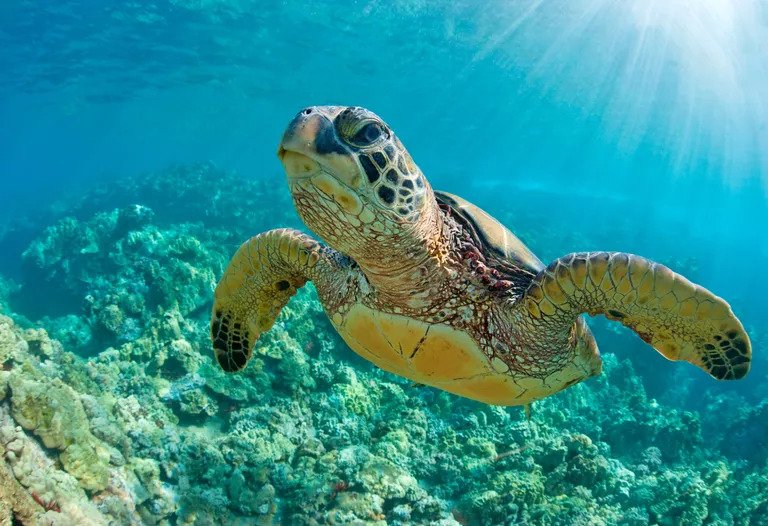Sea turtle’s diet predominantly depends on the age and specific kind of species. Marine turtles normally eat a wide variety of food. Normally, these turtles are omnivores i.e. they rely on both plants and animals. There is only one exception to this rule i.e. green sea turtle. The adult green turtles are the only species that are strictly herbivores even though young turtles are mostly carnivores. On the contrary, there are few species of marine turtles that are specialists.
READ MORE: [What Do Leatherback Sea Turtles Eat?]
That being said, few marine turtles also tend to change their diet over time. As an illustration, the juvenile green turtles are predominantly carnivorous whereas the adult green turtles are strictly herbivorous.
In addition to this, the shape of the turtle’s mouth as well as the structure of its jaws also play a vital role in the feeding habits of sea turtles. That is to say, the mouth of a turtle determines the kind of diet that particular species is going to eat. For this reason, the jaw structure of carnivorous species of aquatic turtles will be will be different from those of herbivores. Now let’s take a look at the diet of each of the seven species of marine turtles and find out what food do sea turtles eat!
What Do Sea Turtles Eat In The Ocean?
Green turtles have a beak-like mouth with finely serrated edges. Juvenile green turtles are carnivorous while the adult turtles are strictly herbivorous. Thus, the diet of these turtles mainly depends upon the age of the turtle because they tend to change it over time. Juveniles tend to eat fish eggs, jellyfish and sponges. The adults usually feed on beds of sea grasses and algae.
READ MORE: [What Do Loggerhead Sea Turtles Eat?]
Leatherback turtles lack teeth but their jaws possess sharp cusps, just like that of a scissor. The preferred prey of leatherbacks are jellyfish and such other gelatinous species.
Loggerhead turtles have powerful jaws and they can easily crush prey having hard shells. They are predominantly carnivorous and they readily feed on horseshoe crabs, clams and conch.
Hawksbills have beak-like short mouths. They usually feed on reefs and can pull out prey like sponges, shrimp and squid from the crevices.
Australian flatbacks are mostly carnivorous species. However, they also eat plant material. The preferred prey of flatbacks are jellyfish, soft corals and sea cucumbers.
Generally, olive ridleys are omnivores but they tend to eat predominantly carnivorous diet, mainly the juveniles. By means of powerful jaws, they normally eat jellyfish, sea urchins, crabs and rock lobsters.
Kemp’s ridleys have slightly hooked beak and they feed on animals that are at the bottom of the sea floor. Kemp’s ridleys usually eat different kinds of benthic animals but their preferred prey is crabs. In addition to these, they also eat jellyfish, mollusks, seaweed and several crustaceans.
What Do Sea Turtles Eat In Hawaii?
Out of a total of seven sea turtle species, five of them occur in the coastal waters of Hawaii. However, the two most common species in the Hawaiian waters are green sea turtle and hawksbill sea turtle. Green turtles are pretty much the favorite among local people, simply because they occur in the entire archipelago of Hawaii. Hawaiian green sea turtles are also known as “honu”. These turtles occupy nearshore Hawaiian waters and often feed on shallow reefs and bays.
READ MORE: [What Do Green Sea Turtles Eat?]
For the people of Hawaii, the Hawaiian honu holds special importance because it is a symbol of good luck. Moreover, it is the only reptile in the state of Hawaii that is native to this region.
Hawaiian Green turtles are vegetarian species. Thus, when it comes to eating, they predominantly feed on red, green algae as well as beds of seagrass. Actually, coastal shallow waters of Hawaii contains 400 species of algae. Therefore, green turtles seem to prefer these vegetation growing on the reefs and rocks of Hawaiian waters.
Apart from these two species, some of the other aquatic turtles like olive ridleys, loggerheads and leatherbacks also make their home to the waters of Hawaii. However, these marine turtles mostly occur in offshore, deep waters.
On the southern and western coastlines of Maui island, the sighting of sea turtles offers great delight for the snorkelers and divers. In particular, the sighting of green turtles is quite common during snorkeling in Maui. The Hawaiian people often witness sea turtles reaching up to the water surface for breathing. The beaches of Hawaii also offer a great resting platform for sea turtles as they often bask in the sun.
It is a great fun to swim with sea turtles in Maui. However, make sure that you do not harass them by coming too close to them because it is illegal in Hawaii. In case of violating the sea turtle rules, there can be a fine of $100,000 in the state of Hawaii. Besides, while swimming, stay at a distance of not less than 15 feet from marine turtles and do not spread out your arms.
